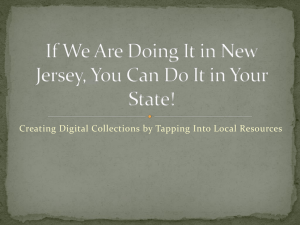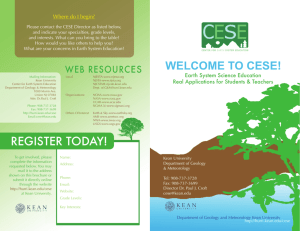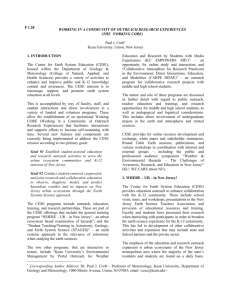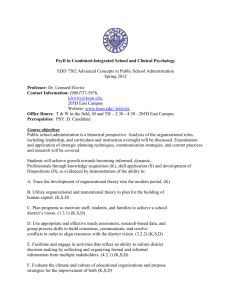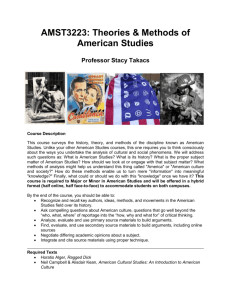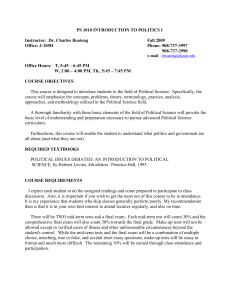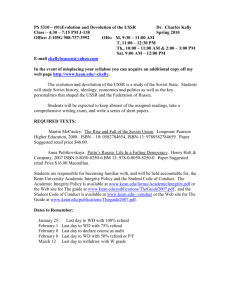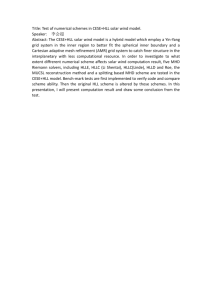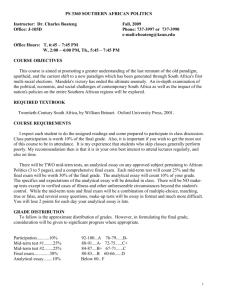KEAN UNIVERSITY'S WEATHER HAZARD EDUCATION
advertisement
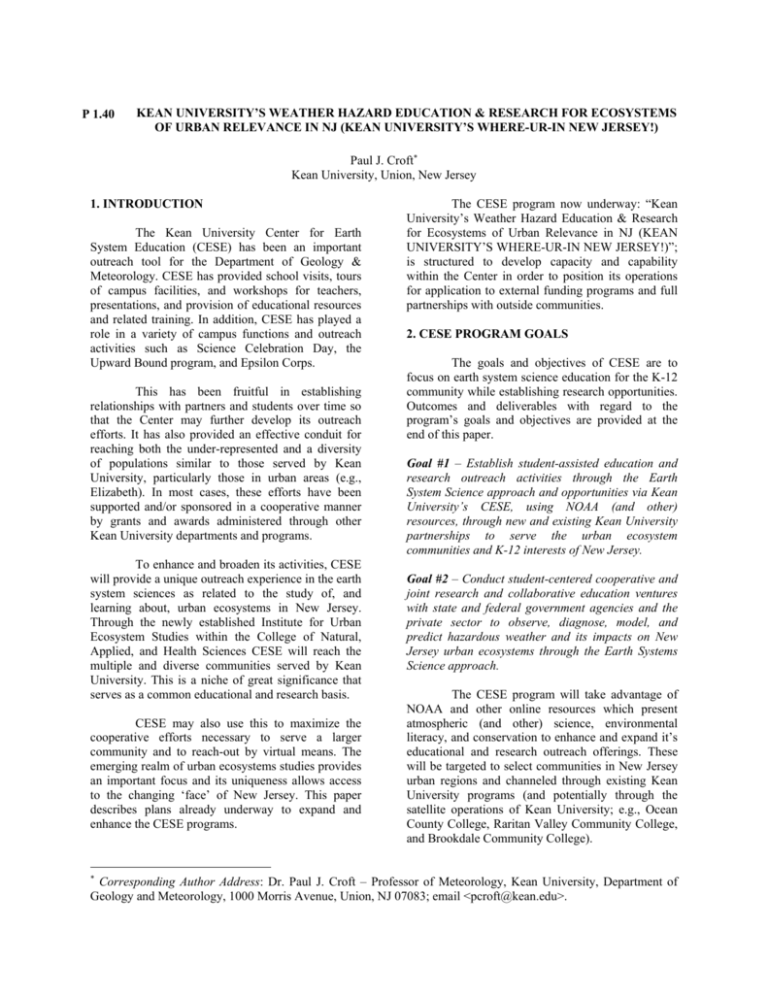
P 1.40 KEAN UNIVERSITY’S WEATHER HAZARD EDUCATION & RESEARCH FOR ECOSYSTEMS OF URBAN RELEVANCE IN NJ (KEAN UNIVERSITY’S WHERE-UR-IN NEW JERSEY!) Paul J. Croft∗ Kean University, Union, New Jersey 1. INTRODUCTION The Kean University Center for Earth System Education (CESE) has been an important outreach tool for the Department of Geology & Meteorology. CESE has provided school visits, tours of campus facilities, and workshops for teachers, presentations, and provision of educational resources and related training. In addition, CESE has played a role in a variety of campus functions and outreach activities such as Science Celebration Day, the Upward Bound program, and Epsilon Corps. This has been fruitful in establishing relationships with partners and students over time so that the Center may further develop its outreach efforts. It has also provided an effective conduit for reaching both the under-represented and a diversity of populations similar to those served by Kean University, particularly those in urban areas (e.g., Elizabeth). In most cases, these efforts have been supported and/or sponsored in a cooperative manner by grants and awards administered through other Kean University departments and programs. To enhance and broaden its activities, CESE will provide a unique outreach experience in the earth system sciences as related to the study of, and learning about, urban ecosystems in New Jersey. Through the newly established Institute for Urban Ecosystem Studies within the College of Natural, Applied, and Health Sciences CESE will reach the multiple and diverse communities served by Kean University. This is a niche of great significance that serves as a common educational and research basis. CESE may also use this to maximize the cooperative efforts necessary to serve a larger community and to reach-out by virtual means. The emerging realm of urban ecosystems studies provides an important focus and its uniqueness allows access to the changing ‘face’ of New Jersey. This paper describes plans already underway to expand and enhance the CESE programs. ∗ The CESE program now underway: “Kean University’s Weather Hazard Education & Research for Ecosystems of Urban Relevance in NJ (KEAN UNIVERSITY’S WHERE-UR-IN NEW JERSEY!)”; is structured to develop capacity and capability within the Center in order to position its operations for application to external funding programs and full partnerships with outside communities. 2. CESE PROGRAM GOALS The goals and objectives of CESE are to focus on earth system science education for the K-12 community while establishing research opportunities. Outcomes and deliverables with regard to the program’s goals and objectives are provided at the end of this paper. Goal #1 – Establish student-assisted education and research outreach activities through the Earth System Science approach and opportunities via Kean University’s CESE, using NOAA (and other) resources, through new and existing Kean University partnerships to serve the urban ecosystem communities and K-12 interests of New Jersey. Goal #2 – Conduct student-centered cooperative and joint research and collaborative education ventures with state and federal government agencies and the private sector to observe, diagnose, model, and predict hazardous weather and its impacts on New Jersey urban ecosystems through the Earth Systems Science approach. The CESE program will take advantage of NOAA and other online resources which present atmospheric (and other) science, environmental literacy, and conservation to enhance and expand it’s educational and research outreach offerings. These will be targeted to select communities in New Jersey urban regions and channeled through existing Kean University programs (and potentially through the satellite operations of Kean University; e.g., Ocean County College, Raritan Valley Community College, and Brookdale Community College). Corresponding Author Address: Dr. Paul J. Croft – Professor of Meteorology, Kean University, Department of Geology and Meteorology, 1000 Morris Avenue, Union, NJ 07083; email <pcroft@kean.edu>. This will enable the development of a “Roundtable Earth” program to link participants from the state in a common pedagogical framework with connections to Kean University students and faculty. From these CESE will create a formal research outreach program to middle and high school students in order to broaden their experiences (students and their teachers) as they integrate the study of science with urban interests to better understand relationships between the natural environment and human settings. Some of this research will be accomplished through a pairing with the “KU WE MAP IT” program being established. The Kean University Weather and Ecosystems Monitoring, Assessment, and Prediction for Integration and Training provides for a real-time weather monitoring, assessment, and research portal for the Kean University campus ecosystem for studies of weather extremes and hazards and provide class-related activities and learning experiences. Data from the system will provide assessment of hazardous conditions on campus in real-time and will offer student opportunities to partner with faculty on research projects while learning from in-situ observational and situational experiences. The creation of this portal for monitoring, assessment, and research will provide new and continuing instructional opportunities that incorporate technical and practical methods that also form a basis for external funding opportunities. With these components in place the Center will develop cooperative and collaborative research liaisons with federal and state government and the private sector. The intent is to improve understanding of the urban environment, its observation, analysis, modeling, and prediction for short and long term planning and uses. These will provide for public outreach on hazardous weather conditions in the urban environment so as to provide important safety, training, and community preparedness programs. 3. INITIAL OUTCOMES During the summer and fall the “WHERE – UR – in New Jersey!” Program, CESE has prepared and delivered a white paper on earth system education (see http://hurri.kean.edu and click on CESE), instituted website revisions, disseminated an informational brochure at the New Jersey Science Teachers Association, and delivered a presentation at the National Weather Association Conference. The program has explored the NOAA Environmental Literacy Grant Program (within the NOAA Education Office and part of the NOAA Education Plan) and is developing a concept for later submittal. In addition, three students are being supported to assist in the development of programs for the academic year, lesson and curricular plan templates for use in outreach activities, identification of resources, and other activities. Initial contact with several school systems to explore a research collaborative between students and faculty at Kean University and select middle/high schools is underway. Coordination with the New Jersey Center for Science, Technology, and Mathematics Education (NJCSTME) is in progress. A School Connections article entitled “The Atmosphere: Science and Math System Integrator across the Curriculum” was published. 4. NEXT STEPS Ongoing work includes the delivery of the Roundtable Earth and workshops (workshop/guest speaker and educational session with regard to content and pedagogy) to be delivered at the New Jersey Earth Science Teachers Association (in April 2008). On campus efforts will link to Science Celebration Day and similar events as sponsored by Epsilon Corps and Kean University programs and offices (e.g., McNair project). In addition, CESE will coordinate with both the Institute for Urban Ecosystems Studies on campus and the New Jersey Academy of Sciences annual conference. During the second year, the CESE outreach program and activities expansion will continue according to established goals and objectives given previously. The main emphases will be to build upon completion of online integration of resources, teacher workshops, Roundtable Earth, and educational sessions. These will provide for an urban ecosystem curricular guide and stakeholder white paper as well as virtual linkage for cooperative & collaborative research workshops, a website hub with pedagogy, and initiation of research outreach projects. ACKNOWLEDGEMENTS Support from the Department of Geology & Meteorology and the Kean University Foundation is appreciated. Coordination and assistance with the Institute for Urban Ecosystems Studies, College of Natural, Applied, and Health Sciences; and Office of Research and Sponsored Programs are also noted. (1) Infuse NOAA and other science education resources into existing outreach programs in CESE and the Department of Geology & Meteorology. (Goal #1) Outcomes Strategies Activities Deliverables NOAA Education Office materials incorporated with CESE operations (through NJESTA, others) and NOAA Education Report as guideline for outreach development; incorporation of same with introductory courses in Department; and applications of Earth System Science (ESS) methods to urban ecosystem pedagogy Promote the ESS approach for learning & studying urban ecosystems of New Jersey through online resources and contact with K-12 teachers through existing Kean University outreach programs Develop and deliver a hazardous weather impacts program and provide ESS curricular guidance for teachers as related to urban ecosystems in New Jersey (a) Website integration of NOAA (and other) online resources; (b) Teacher workshop; and (c) Urban ecosystem ESS curricular guide for teachers (2) Establish “Roundtable Earth” as focal point of CESE outreach mission to encourage & support educational, research, & collaborative opportunities with multiple and diverse communities (Goals #1, #2) Outcomes Strategies Activities Deliverables Roundtable Earth and initial session “Wonders and Hazards to Observe – by You!” (“WHO? – You!”); climate and weather phenomena affecting urban ecosystem environments and conservation practices Development of several sessions per year; involvement of K-12 participants, invited guests, and stakeholder communities; and planning & initiation of activities Seminars & training, identification of research and collaborative opportunities to teach and study urban ecosystems of New Jersey, and determine educational needs for effective ESS approach to urban ecosystems (a) Roundtable Earth; (b) Educational sessions; and (c) Stakeholder white paper on urban ecosystems teaching & research in New Jersey (3) Create capacity for research outreach to high school and middle school students (Goal #1) Outcomes Strategies Activities Deliverables Summer and academic year virtual research network for selected middle and high school students from partners and coordinated use of real-time local and mesonet data sets online with regard to urban ecosystem environments in New Jersey Incorporation of urban ecosystem studies and weather hazards with Kean University undergraduate student research projects and involvement of the grade 5-12 teacher communities Research workshop for teachers, research workshop for grade 5-12 students, research collaboration workshop for teachers, students, and Kean University students (a) Virtual linkage for research outreach program; (b) Cooperative & collaborative research investigation workshops & with partners; (c) Website “hub” for data sets for use in studying & teaching about urban ecosystems; and (d) Initiation of research outreach projects (4) Develop enhanced capabilities in research and education through and between internal and external liaisons and partnerships (Goals #1, #2) Outcomes Strategies Activities Deliverables New Jersey urban ecosystems research projects within Kean University and with outside colleagues and in liaison with state and federal government agencies as well as private sector communities Exchange opportunities (e.g., seminars, workshops), improved understanding of New Jersey urban ecosystems through cross-disciplinary analysis & modeling Research partners collaborative working group, exchange program, verification & modeling task force, and proposal development (a) Cooperative & collaborative research projects initiated; (b) Professional exchanges; (c) Real-time operational evaluation of weather hazards in urban ecosystems; (d) Real-time verification & modeling; and (e) Proposals developed for external funding (5) Promote through various media public interaction with regard to hazardous weather conditions in terms of safety, training, research, and community preparedness (Goal #2) Outcomes Strategies Activities Deliverables Awareness programs, informal training workshops, liaison with community leaders and emergency management and similar government (including local) entities as well as the private sector Coordination with Kean University & commercial media outlets, hazards working group for education, safety, & research needs, and sponsorships Hazards working group, media liaisons, and public promotions planning (a) Media information for dissemination; (b) Public programs, workshops; (c) Student & faculty resource agents, and (d) Proposals submitted for external funding
